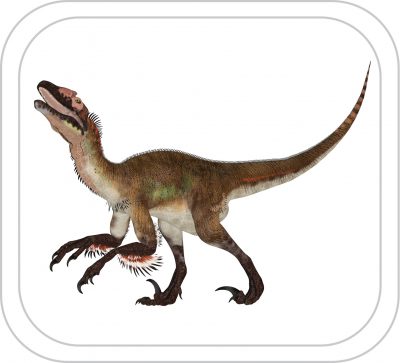Utahraptor
Name: Utahraptor
Pronounced: YOO-tah-RAP-tor
Meaning: Utah plunderer, as the first fossils were found in Utah, North America.
Period: Early Cretaceous (112 – 100 million years ago)
Group: Theropods (beast feet)
Size: It was 6m long and 2m tall. It weighed approximately 1000kg.
Diet: Carnivore
Characteristics: The Utahraptor walked on two legs and had a curved, flexible neck supporting a massive head. It is believed to have had the highest intelligence amongst all the dinosaurs because it had such a big head. Its long tail was excellent for making fast turns and for keeping balance because it had bony rods running along the spine to keep it stiff. There were three fingers on the front limbs which all had large, sharp, curved claws and four toes on its back feet. The second back toe on each foot had a 23cm – 38cm sickle-like claw, whilst the others had shorter claws. Some believe the Utahraptor may have had feathers because they have identified lumps on the skin where the feathers might have been anchored. It may have hunted in packs and probably ate anything it could slash and tear apart with its sharp, serrated teeth, even attacking very large animals.
Named by: James Kirkland, Robert Gaston, and Donald Burge in 1993
Discovery: The first specimens of Utahraptor were found in 1975 by Jim Jensen in the Dalton Wells Quarry in east-central Utah, near the town of Moab, but did not receive much attention. In October 1991, Carl Limoni found a large foot claw in the Cedar Mountain Formation, Gaston Quarry in Grand County, Utah. Further investigation of the Cedar Mountain Formation by James Kirkland, Robert Gaston, and Donald Burge uncovered a fragmentary skeleton, including several large, sharp, curved claws.

